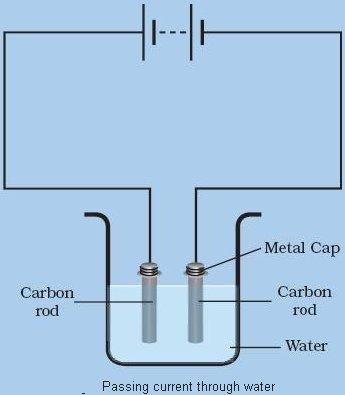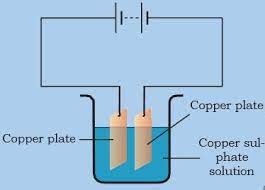CHEMICAL EFFECTS OF ELECTRIC CURRENT for Class 8 SCIENCE
Introduction
Hamare chapter ka name hai ”Chemical effects of electric current”, toh jaisa ki hum jante hai ki jab electric current flow karta hai toh woh different type ke effects produce karta hai, unme se hi ek iske chemical effects bhi hai. Iss chapter mein hum current ke chemical effects ke baare mein janege. Hum dekhenge ki jaise solid substance electricity conduct karte hai kya ussi tarah liquids bhi electricity conduct karte hai? Iske baad hum janege ki yeh electricity conduct kaise karte hai aur kya- kya chemical effects produce karte hai. Iss chapter mein hum janege ki electrodes kya hoti hai, electroplating kya hoti hai, different objects par electroplating kyo aur kaise ki jati hai, etc. Yaha hum electroplating ki applications ke baare mein bhi padhenge.
Do Liquids Conduct Electricity?
Liquids electricity conduct karte hai lekin sabhi liquids electricity conduct nahi karte isliye kuchh liquids electricity ke good conductors hote hai aur kuchh poor conductors hote hai.
Hum tester ki help se check kar sakte hai ki kounsa liquid electricity conduct karta hai aur kounsa liquid electricity conduct nahi karta.
Conductivity ko check karne ke liye hum liquid ko tester ke do ends ke beech mein connect karte hai.

Jab tester ke do ends ke beech mein present liquid electric current ko pass karta hai toh tester ka circuit complete ho jata hai. Agar iss circuit mein laga bulb glow karta hai toh iska matlab hai ki liquid conducting hai ya ek good conductor hai aur agar yeh bulb glow nahi karta toh matlab yeh liquid conducting nahi hai. Jo solutions electricity ko conduct karte hai woh mostly acid, base aur salt ke solutions hote hai.
Sometimes aisa hota hai ki liquid conducting hota hai fir bhi bulb glow nahi karta, aisa kyo hota hai?
Aisa isliye hota hai kyonki bulb glow karne ke liye electric current ke heating effect ka use karta hai. Heating effect of current ki wajah se bulb ki filament itni jyada heat ho jati hai ki bulb glow karta hai. Lekin agar circuit mein current weak hoga toh filament heat nahi ho payegi aur bulb glow nahi karega.
Weak current ko check karne ke liye hum electric current ka ek aur effect use karke ek aur tarah ka tester bana sakte hai. Hum magnetic field of electric current ka use karke ek aur tester bana sakte hai aur isme hum bulb ki jagah LED ka use karenge kyonki LED ki filament ko glow karne ke liye jyada temperature ki need nahi hoti isliye yeh weak current ke flow par bhi glow karti hai.
Hum materials ko conductors aur insulators mein classify isliye nahi karte kyonki mostly materials kuchh certain conditions provide karne par electricity conduct karte hai isliye inko good conductors aur poor conductors mein classify kiya jata hai.
Ab hum kuchh samples lenge aur test karenge ki woh good conductors hai ya poor conductors hai. Yeh data hum niche table mein record karenge.

Jab ek conducting solution mein se electric current pass hota hai toh yeh kuchh chemical effects bhi produce karta hai. Next topic mein hum inn effects ke baare mein padhenge.
Chemical Effects Of Electric Current
Electric current jab conducting solutions mein se pass hota hai toh kuchh chemical reactions cause karta hai jiske kuchh effects hamein dekhne ko milte hai. Eg- Electrodes par gas ke bubbles form hone start ho jate hai, electrodes par metal ke deposits dekhne ko milte hai, solution mein color changes dekhne ko milte hai. etc.
Lekin yeh electrodes kya hote hai?
Yeh ek conducting material hota hai jiske through current ek substance mein enter karta hai ya usko leave karta hai. Electrode ke do terminals hote hai- positive terminal aur negative terminal.
1800 mein ek british chemist, William Nicholson ne show kiya tha ki jab hum electrodes ko water mein immerse karte hai aur usme se current pass karte hai toh positive terminal se connected electrode par oxygen bubbles bante hai aur negative terminal se connected electrode par hydrogen bubbles bante hai.
Hum niche figure mein iska setup dekh sakte hai.

Electroplating
Ek aisa process jisme kisi material par electricity ke help se ek desired metal ki plating ki jati hai uss process ko electroplating kehte hai. Iska example dekhne ke liye hum ek experiment perform karenge.

Electroplating ek bahut useful process hai, ab hum iski kuchh applications ke baare mein padhenge.
POINT 1
Conductors: An electrical conductor is defined as materials that allow electricity to flow through them easily.
Insulators: A material or an object that does not easily allow heat, electricity, light, or sound to pass through it.
Tester: A tester is a piece of electrical equipment used to check the presence of electric current.
Electrode: It is the metallic rod/conductor through which electricity enters or leaves an electrolyte.
Electroplating: The process of depositing a layer of desired metal on another material by means of electricity is known as electroplating.
SUMMARY
1. Some liquids are good conductors of electricity and some are poor conductors.
2. Most liquids that conduct electricity are solutions of acids, bases and salts.
3. The passage of an electric current through a conducting liquid causes chemical reactions. The resulting effects are called chemical effects of currents.
4. The process of depositing a layer of any desired metal on another material, by means of electricity, is called electroplating.